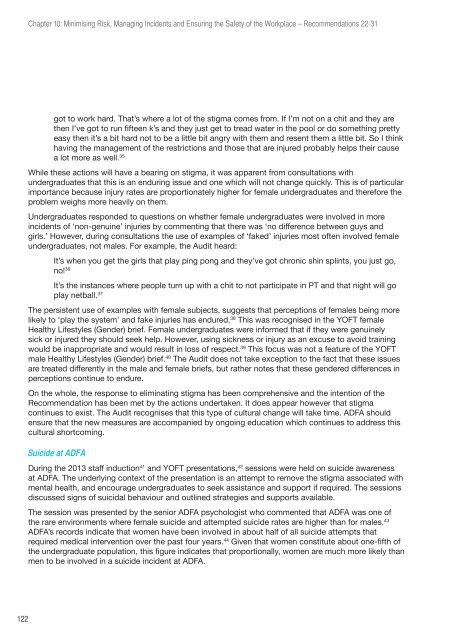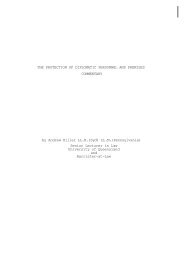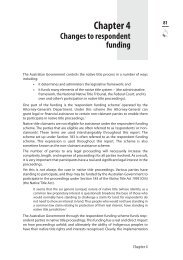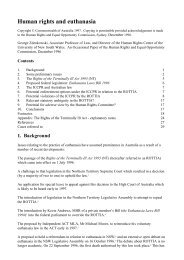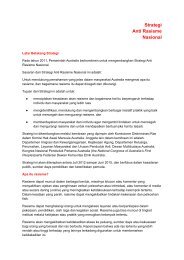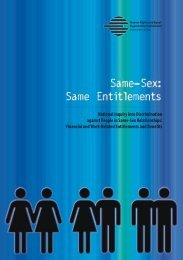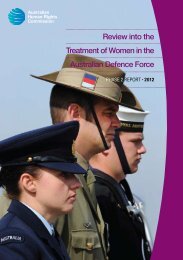Review into the treatment of women at the Australian Defence Force ...
Review into the treatment of women at the Australian Defence Force ...
Review into the treatment of women at the Australian Defence Force ...
- No tags were found...
You also want an ePaper? Increase the reach of your titles
YUMPU automatically turns print PDFs into web optimized ePapers that Google loves.
Chapter 10: Minimising Risk, Managing Incidents and Ensuring <strong>the</strong> Safety <strong>of</strong> <strong>the</strong> Workplace – Recommend<strong>at</strong>ions 22-31got to work hard. Th<strong>at</strong>’s where a lot <strong>of</strong> <strong>the</strong> stigma comes from. If I’m not on a chit and <strong>the</strong>y are<strong>the</strong>n I’ve got to run fifteen k’s and <strong>the</strong>y just get to tread w<strong>at</strong>er in <strong>the</strong> pool or do something prettyeasy <strong>the</strong>n it’s a bit hard not to be a little bit angry with <strong>the</strong>m and resent <strong>the</strong>m a little bit. So I thinkhaving <strong>the</strong> management <strong>of</strong> <strong>the</strong> restrictions and those th<strong>at</strong> are injured probably helps <strong>the</strong>ir causea lot more as well. 35While <strong>the</strong>se actions will have a bearing on stigma, it was apparent from consult<strong>at</strong>ions withundergradu<strong>at</strong>es th<strong>at</strong> this is an enduring issue and one which will not change quickly. This is <strong>of</strong> particularimportance because injury r<strong>at</strong>es are proportion<strong>at</strong>ely higher for female undergradu<strong>at</strong>es and <strong>the</strong>refore <strong>the</strong>problem weighs more heavily on <strong>the</strong>m.Undergradu<strong>at</strong>es responded to questions on whe<strong>the</strong>r female undergradu<strong>at</strong>es were involved in moreincidents <strong>of</strong> ‘non-genuine’ injuries by commenting th<strong>at</strong> <strong>the</strong>re was ‘no difference between guys andgirls.’ However, during consult<strong>at</strong>ions <strong>the</strong> use <strong>of</strong> examples <strong>of</strong> ‘faked’ injuries most <strong>of</strong>ten involved femaleundergradu<strong>at</strong>es, not males. For example, <strong>the</strong> Audit heard:It’s when you get <strong>the</strong> girls th<strong>at</strong> play ping pong and <strong>the</strong>y’ve got chronic shin splints, you just go,no! 36It’s <strong>the</strong> instances where people turn up with a chit to not particip<strong>at</strong>e in PT and th<strong>at</strong> night will goplay netball. 37The persistent use <strong>of</strong> examples with female subjects, suggests th<strong>at</strong> perceptions <strong>of</strong> females being morelikely to ‘play <strong>the</strong> system’ and fake injuries has endured. 38 This was recognised in <strong>the</strong> YOFT femaleHealthy Lifestyles (Gender) brief. Female undergradu<strong>at</strong>es were informed th<strong>at</strong> if <strong>the</strong>y were genuinelysick or injured <strong>the</strong>y should seek help. However, using sickness or injury as an excuse to avoid trainingwould be inappropri<strong>at</strong>e and would result in loss <strong>of</strong> respect. 39 This focus was not a fe<strong>at</strong>ure <strong>of</strong> <strong>the</strong> YOFTmale Healthy Lifestyles (Gender) brief. 40 The Audit does not take exception to <strong>the</strong> fact th<strong>at</strong> <strong>the</strong>se issuesare tre<strong>at</strong>ed differently in <strong>the</strong> male and female briefs, but ra<strong>the</strong>r notes th<strong>at</strong> <strong>the</strong>se gendered differences inperceptions continue to endure.On <strong>the</strong> whole, <strong>the</strong> response to elimin<strong>at</strong>ing stigma has been comprehensive and <strong>the</strong> intention <strong>of</strong> <strong>the</strong>Recommend<strong>at</strong>ion has been met by <strong>the</strong> actions undertaken. It does appear however th<strong>at</strong> stigmacontinues to exist. The Audit recognises th<strong>at</strong> this type <strong>of</strong> cultural change will take time. ADFA shouldensure th<strong>at</strong> <strong>the</strong> new measures are accompanied by ongoing educ<strong>at</strong>ion which continues to address thiscultural shortcoming.Suicide <strong>at</strong> ADFADuring <strong>the</strong> 2013 staff induction 41 and YOFT present<strong>at</strong>ions, 42 sessions were held on suicide awareness<strong>at</strong> ADFA. The underlying context <strong>of</strong> <strong>the</strong> present<strong>at</strong>ion is an <strong>at</strong>tempt to remove <strong>the</strong> stigma associ<strong>at</strong>ed withmental health, and encourage undergradu<strong>at</strong>es to seek assistance and support if required. The sessionsdiscussed signs <strong>of</strong> suicidal behaviour and outlined str<strong>at</strong>egies and supports available.The session was presented by <strong>the</strong> senior ADFA psychologist who commented th<strong>at</strong> ADFA was one <strong>of</strong><strong>the</strong> rare environments where female suicide and <strong>at</strong>tempted suicide r<strong>at</strong>es are higher than for males. 43ADFA’s records indic<strong>at</strong>e th<strong>at</strong> <strong>women</strong> have been involved in about half <strong>of</strong> all suicide <strong>at</strong>tempts th<strong>at</strong>required medical intervention over <strong>the</strong> past four years. 44 Given th<strong>at</strong> <strong>women</strong> constitute about one-fifth <strong>of</strong><strong>the</strong> undergradu<strong>at</strong>e popul<strong>at</strong>ion, this figure indic<strong>at</strong>es th<strong>at</strong> proportionally, <strong>women</strong> are much more likely thanmen to be involved in a suicide incident <strong>at</strong> ADFA.122


